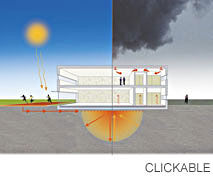Domestic RHI – Tax free income – index linked – paid over seven years
The initially published rates for Domestic RHI applied from 9 April 2014. The rates for GSHPs are significantly higher than the proposed rates in the 2013 consultation paper following representations from the Ground Source Heat Pump Association. The d-RHI tariff for GSHPs was set at 18.8 pence a kWhr. The biomass rate was set at 12.2 pence, but has since been reduced to 7.14p for new applications from 1 July 2015. The air source heat pump rate was set at 7.3 pence/kWhr.
Renewable heat installations commissioned since 15 July 2009 can receive a cashback subsidy of around 19 pence per kilowatt hour used – for the first seven years of the equipment used.
The RHI tariff table below shows the technologies that are eligible for Domestic RHI and the tariffs for each technology. The RHI provides a major incentive for owners to invest in ground source heat pumps and solar thermal renewable heat technologies. The tariffs are based on pence/kWh of deemed renewable heat delivered. The rates vary with the technology used as follows:
| Renewable Heat Incentive Domestic |
p/kWh from Jan 15 |
p/kWh from April |
p/kWh from July |
p/kWh from Oct |
p/kWh from Jan 16 |
p/kWh from Apr 16 |
p/kWh from Jul 16 |
p/kWh from Jan 17 |
p/kWh from Jul 17 |
Tariff lifetime in years |
| Solar thermal | 19.2 | 19.51 | 19.51 | 19.51 | 19.51 | 19.74 | 19.74 | 19.74 | 20.06 | 7 |
| Ground source heat pumps | 18.80 | 19.10 | 19.10 | 19.10 | 19.10 | 19.33 | 19.33 | 19.33 | 19.86 | 7 |
| Biomass | 10.98 | 8.93 | 7.14 | 6.43 | 5.14 | 5.20 | 4.68 | 4.21 | 3.85 | 7 |
| Air source heat pumps | 7.3 | 7.42 | 7.42 | 7.42 | 7.42 | 7.51 | 7.51 | 7.51 | 7.63 | 7 |
To receive RHI for a domestic building, each system must be installed by an MCS certified installer.
Each domestic building must show an Energy Performance Certificate to evidence its energy use.
The biomass tariff fell from 12.2p to 10.98p on 1 Jan 2015 and has since fallen to 3.85 from July 2017.
Deeming of heat used for Domestic RHI
DECC plans for Ofgem to pay RHI on the basis of the deemed heat used by a property, as evidenced by an Energy Performance Certificate done as part of an Green Deal Assessment required to qualify for Domestic RHI.
However, second properties and those with fossil fuel heating alternatives will have to install meters and be paid on heat generated (up to the limit for deemed heating).
RHI Administration by Ofgem
The RHI is administered by Ofgem. Owners of renewable heat technologies included apply to Ofgem who will pay tariffs, on a quarterly basis, over seven years. For installations rated up to 45 kW capacity the equipment and the installers will need to be MCS certified, or equivalent.
On 9 April 2014 Ofgem opened its servers for Domestic RHI applications. You can apply here.
Comment on the Renewable Heat Incentive
While there are a number of renewable energy options to be considered, ICAX believes the most practical and affordable answer to generating Renewable Heat is to use Interseasonal Heat Transfer.
The RHI provides a positive step change in the business case for delivering on-site renewable heat, not only to reduce energy bills and carbon emissions, but also to deliver an energy related cash flow into your building.
RHI Tax free income – index linked – paid for seven years
Tariffs are exempt from income tax. This means that domestic users and other income tax payers are not taxed on any income received from the Feed-In Tariffs or the Renewable Heat Incentive.
RHI payments are also index linked – they are adjusted for inflation on 1 April each year.
For those using IHT, the annual clean energy cashback for heating will normally be larger than the annual running cost.
See also: Banking on IHT The Merton Rule Ground Source Energy Economic Renewable Energy
See also: How Ground Source Heat Pumps work
See also: Ground Source Heating

